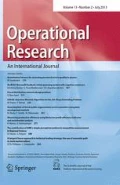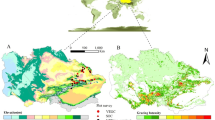Abstract
The effects of the foreseen change in precipitation and temperature on dynamic grazing systems that are managed under the hypothesis of the maximum sustainable yield (MSY) are assessed. The standard Gordon Schaefer approach that relates the rate of above-ground vegetation production to biomass consumption by herbivores is adopted to simulate the grazing system. In order to account for future climate variability, the model is modified using principles from water balance hydrology, thus introducing vegetation growth limitations due to climatic aridity. The model is applied for an equilibrium established under the much criticized MSY hypothesis that assumes the optimum herbivore density for maximum biomass removal. Sensitivity analysis results indicate that as climate changes towards a warmer and drier future, the probability of a low ecological stability grazing system to collapse increases, especially in arid environments where water is a limited resource. Such sudden shifts that lead to undesirable stable states of arid ecosystems are investigated by the CASCADE EU project.





Similar content being viewed by others
References
Adeel Z, Safriel U, Niemeijer D, White R, de Kalbermatten G, Glantz M, Salem B, Scholes R, Niamir-Fuller M, Ehui S et al (2005) Ecosystems and human well-being: desertification synthesis. World Resources Institute, Washington, DC
Allen-Diaz B, Chapin FS, Diaz S, Howden M, Puigdefabregas J, Stafford Smith M (1996) Rangelands in a changing climate: impacts, adaptations, and mitigation. In: Watson WT, Zinyowera MC, Moss RH, Dokken DJ (eds) Climate change 1995—impacts, adaptation and mitigation. Cambridge University Press, Cambridge, pp 131–158
Anderies JM, Janssen MA, Walker BH (2002) Grazing management, resilience, and the dynamics of a fire-driven rangeland system. Ecosystems 5:23–44
AWC (2009) Arab Water Council, Vulnerability of arid and semi-arid regions to climate change: impacts and adaptive strategies. In Perspective Document for the 5th World Water Forum, World Water Council, Marseille, Co-operative Programme on Water and Climate (CPWC), The Hague, IUCN, Gland and International Water Association (IWA), The Hague. 2009
Ayal Y, Polis GA, Lubin Y, Goldberg DE (2005) How can high animal biodiversity be supported in low productivity deserts? The role of macrodetrivory and physiognomy. In: Shachak M, Wade R (eds) Biodiversity in drylands. Cambridge University Press, Cambridge, pp 15–29
Ayres MP (1993) Plant defense, herbivory, and climate change. Biot Interact Glob Change 75:94
Bates B, Kundzewicz ZW, Wu S, Palutikof J (2008) Climate change and water. Technical paper. Intergovernmental Panel on Climate Change (IPCC), Geneva, p 210
Blaney HF, Criddle WD (1962) Determining consumptive use and irrigation water requirements. USDA Technical Bulletin 1275. US Department of Agriculture, Beltsville
Branson FA, Gifford GF, Renard KG, Hadley RF (1981) Rangeland hydrology. Society for Range Management, Range Science Series 1. Dubuque Ia Usa Kendallhunt Publ. Co
Bunn C, Ovalle-Rivera O, Läderach P, Mosnier A, Obersteiner M, Kirschke D (2013) The utility of an agro-ecological niche model of coffee production for future change scenarios. Presented at the Impacts World 2013: International Conference on Climate Change Effects, Potsdam, May 27–30
Cao M, Prince SD, Small J, Goetz SJ (2004) Remotely sensed interannual variations and trends in terrestrial net primary productivity 1981–2000. Ecosystems 7:233–242
Ceglar A, Chukaliev O, Duvellier G, Niemeyer S (2013) Water requirements for maize production in Europe under changing climate conditions. Presented at the Impacts World 2013: International Conference on Climate Change Effects, Potsdam, May 27–30
Claessens L, Antle J, Stoorvogel J, Valdivia R, Thornton P, Herrero M (2012) A method for evaluating climate change adaptation strategies for small-scale farmers using survey, experimental and modeled data. Agric Syst 111:85–95
Cline WR (2007) Global warming and agriculture: impact estimates by country. Peterson Institute, USA
Dasgupta S, Mattei FEE (2013) Impact of climate change on crop yields with implications for food security and poverty alleviation. Presented at the Impacts World 2013: International Conference on Climate Change Effects, Potsdam, May 27–30
Djohy G, Edja H, Akponikpè P, Olokesusi F, Belem M (2013) Pastoral strategies for reducing social conflict regarding water resources in climate change context in Benin, West Africa. Presented at the Impacts World 2013: International Conference on Climate Change Effects, Potsdam, May 27–30
Döll P (2002) Impact of climate change and variability on irrigation requirements: a global perspective. Clim Change 54:269–293
Doorenbos J, Kassam AH (1979) Yield response to water. FAO Irrigation and Drainage Paper 33, FAO, Rome
Doorenbos J, Pruitt WO (1975) Guidelines for predicting crop water requirements. FAO Irrigation and Drainage Paper 24, FAO, Rome. Flay, B.R., 1978. Catastrophe theory in social psychology: some applications to attitudes and social behavior. Behav Sci 23:335–350
Gastélum JR, Valdés JB, Stewart S (2009) A decision support system to improve water resources management in the Conchos Basin. Water Resour Manag 23:1519–1548
Gordon HS (1954) The economic theory of a common-property resource: the fishery. J Polit Econ 62:124–142
Hassan R, Scholes R, Ash N (2005) Ecosystems and human well-being: current state and trends: findings of the condition and trends working group v. 1 (Millennium Ecosystem Assessment). Island Press
Hill J, Hostert P, Tsiourlis G, Kasapidis P, Udelhoven T, Diemer C (1998) Monitoring 20 years of increased grazing impact on the Greek island of Crete with earth observation satellites. J Arid Environ 39:165–178
Hudak AT (1999) Rangeland mismanagement in South Africa: failure to apply ecological knowledge. Hum Ecol 27:55–78
Janssen MA, Kohler TA, Scheffer M (2003) Sunk-cost effects and vulnerability to collapse in ancient societies 1. Curr Anthr 44:722–728
Joshi M, Sutton R, Lowe J, Frame D, others (2011) Projections of when temperature change will exceed 2 [deg] C above pre-industrial levels. Nat Clim Change 1: 407–412
Kaczmarek Z, Strzepek KM, Somlyódy L, Priazhinskaya V (1996) Water resources management in the face of climatic/hydrologic uncertainties. Springer
Kéfi S, Rietkerk M, Alados CL, Pueyo Y, Papanastasis VP, ElAich A, de Ruiter PC (2007) Spatial vegetation patterns and imminent desertification in Mediterranean arid ecosystems. Nature 449:213–217
Koutroulis AG, Tsanis IK, Daliakopoulos IN, Jacob D (2013) Impact of climate change on water resources status: a case study for Crete Island, Greece. J Hydrol 479:146–158
Kramer K, Hengeveld G, Schelhaas M-J, van der Werf B, de Winter W (2013) Genetic adaptive response: missing issue in climate change assessment studies. Presented at the Impacts World 2013: International Conference on Climate Change Effects, Potsdam, May 27–30
Kundzewicz ZW, Mata LJ, Arnell N, Döll P, Kabat P, Jiménez B, Miller K, Oki T, Şen Z, Shiklomanov I (2007) Freshwater resources and their management. In: Parry ML, Canziani OF, Palutikof JP, van der Linden P, Hanson CE (eds) Climate change 2007: impacts, adaptation and vulnerability. Contribution of Working Group II to the Fourth Assessment Report of the Intergovernmental Panel on Climate Change. UK, pp. 173–210
Lane LJ, Hakonson TE, Bostick KV (1996) Applications of the water balance approach for estimating plant productivity in arid areas. In: Wild Land Shrub and Arid Land Restoration Symposium: Proceedings. p. 335
Larkin PA (1977) An epitaph for the concept of maximum sustained yield. Trans Am Fish Soc 106:1–11
Legović T, Klanjšček J, Geček S (2010) Maximum sustainable yield and species extinction in ecosystems. Ecol Model 221:1569–1574
Liang G (1982) Net radiation, potential and actual evapotranspiration in Austria. Arch Meteorol Geophys Bioclimatol Ser B 31:379–390
Marchal V, Dellink R, van Vuuren D, Clapp C, Château J, Lanzi E, Magné B, van Vliet J (2011) OECD environmental outlook to 2050: climate change Chapter, Pre-release Version
Matsuda H, Abrams PA (2004) Effects of predator prey interactions and adaptive change on sustainable yield. Can J Fish Aquat Sci 61:175–184
Noy-Meir I (1975) Stability of grazing systems: an application of predator-prey graphs. J. Ecol. 459–481
Parry ML, Canziani OF, Palutikof JP, van der Linden PJ, Hanson CE (2007) IPCC, 2007: climate change 2007: impacts, adaptation and vulnerability. Contribution of working group II to the fourth assessment report of the intergovernmental panel on climate change. Cambridge University Press, Cambridge
Perrings C (1997) Economics of ecological resources: Selected essays. Edward Elgar Publishing
Pickup G, Smith DS (1993) Problems, prospects and procedures for assessing the sustainability of pastoral land management in arid Australia. J Biogeogr 471–487
Puigdefábregas J, Sole A, Gutierrez L, Del Barrio G, Boer M (1999) Scales and processes of water and sediment redistribution in drylands: results from the Rambla Honda field site in Southeast Spain. Earth Sci Rev 48:39–70
Rietkerk M, Dekker SC, de Ruiter PC, van de Koppel J (2004) Self-organized patchiness and catastrophic shifts in ecosystems. Science 305:1926–1929
Robbins CT, Hanley TA, Hagerman AE, Hjeljord O, Baker DL, Schwartz CC, Mautz WW (1987) Role of tannins in defending plants against ruminants: reduction in protein availability. Ecology 98–107
Schaefer MB (1957) Some considerations of population dynamics and economics in relation to the management of the commercial marine fisheries. J Fish Board Can 14:669–681
Scheffer M, Carpenter S, Foley JA, Folke C, Walker B, others (2001) Catastrophic shifts in ecosystems. Nature 413: 591–596
Sombroek WG (1990) Aridisols of the World, occurrence and potential. Charact Classif Util Arid 121–128
Stanhill G, Lake JV, Rudd-Jones D (1985) The water resource for agriculture [and discussion]. philos. Trans R Soc Lond B Biol Sci 310:161–173
Tsanis IK, Koutroulis AG, Daliakopoulos IN, Jacob D (2011) Severe climate-induced water shortage and extremes in Crete. Clim Change 106:667–677
Tsunekawa A (2000) Methodologies of desertification monitoring and assessment. In Proceeding of Workshop of the Asian Regional Thematic Programme Network on Desertification Monitoring and Assessment. UNU, Tokyo, Japan Press. p. 251
Turc L (1961) Estimation of irrigation water requirements, potential evapotranspiration: a simple climatic formula evolved up to date. Ann Agron 12:13–49
Van De Koppel J, Rietkerk M (2000) Herbivore regulation and irreversible vegetation change in semi-arid grazing systems. Oikos 90:253–260
Van Vliet M, Ludwig F, Kabat Pavel (2013) Cross-sectoral conflicts for water under climate change: the need to include water quality impacts. Presented at the Impacts World 2013, International Conference on Climate Change Effects, Potsdam, May 27–30
Villamil MB, Amiotti NM, Peinemann N (2001) Soil degradation related to overgrazing in the semi-arid southern Caldenal area of Argentina. Soil Sci 166:441–452
Wilding LP, Smeck NE, Hall GF (1983) Pedogenesis and soil taxonomy: the soil orders. Elsevier Science
Xue Y, Dirmeyer PA (2004) The Sahelian climate. In: Kabat P, Claussen M, Dirmeyer PA, Gash JHC, Bravo de Guenni L et al (eds.), Vegetation, water, humans, and the climate: a new perspective on an interactive system. Springer, New York, pp. 59–78
Yacoubi S, Zayani K, Zapata N, Zairi A, Slatni A, Salvador R, Playán E (2010) Day and night time sprinkler irrigated tomato: irrigation performance and crop yield. Biosyst Eng 107:25–35
Author information
Authors and Affiliations
Corresponding author
Rights and permissions
About this article
Cite this article
Daliakopoulos, I.N., Tsanis, I.K. Climate-induced catastrophic shifts in pastoralism systems managed under the maximum sustainable yield model. Oper Res Int J 14, 177–188 (2014). https://doi.org/10.1007/s12351-014-0156-7
Received:
Revised:
Accepted:
Published:
Issue Date:
DOI: https://doi.org/10.1007/s12351-014-0156-7




